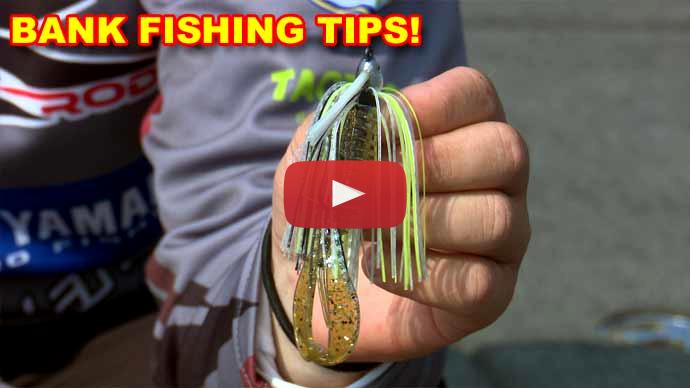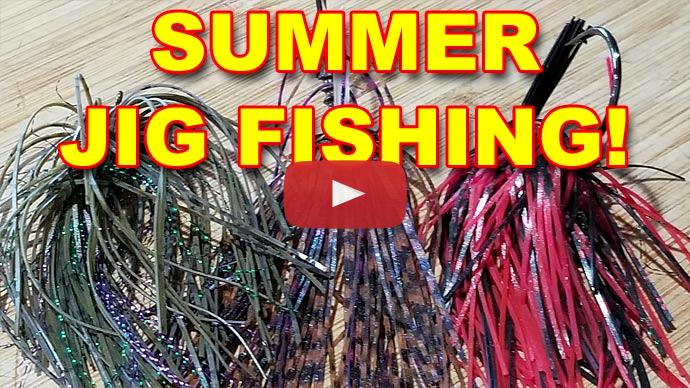Hey guys, Wes Logan here with Bass Resource. Want to talk to you a little bit about summertime swim jig fishing, what I look for, how I work the bait, my set-up, the whole nine yards. Gonna give you guys the goods on all that. So, what's different about when you transition from spring to summertime is gonna be where the fish are setting up and how their feeding patterns are gonna change and all that good stuff. You know, in the springtime the fish are up there, they're thinking about spawning, they're worried about making beds and all that.
And a lot of times the fish that you catch are actually, they could be guarding a bed, they could be guarding fry, they could be just pulling up and getting one or two last meals before they actually get on the bed, locked on. So, you're more of a reaction deal with that, I think, to where when you get into the summertime when he comes up and commits to your bait, it's more of an instinct to eat.
So, I feel like your colors and the actions of your trailers have to be more on cue than normally. So, with that, you know, going into what I look for in the summertime, the fish could still be shallow. Not a lot are you gonna catch fish on a swim jig in 15-foot of water. Not saying it can't happen, but the way that I fish a swim jig is 90% of the time gonna be shallow.
So, I'm still looking for grass, I'm still looking for, you know, bushes, boat docks, something like that. But it's gonna be more...I'm gonna be looking for shade in the summertime, you know, an early morning, you know, two or three-hour window. You're gonna have that going on. Run the shade as long as you can. Whatever may be in the shade, it could be a mixture of grass and rock or whatever that may be.
And I will reiterate on...I just thought about this, in an early summertime situation, there's gonna be a shad spawn going on. So, a lot of time shad like to spawn on anything hard on the edges of something. So it could be on the edges of a floating dock, the edge of some rip-rap, a seawall, you know, the edge of some matted up grass, that's a really good place to check first thing in the morning or late in the evening. That's when those shad are really gonna be the most active, and if you can ever get a day where it's overcast or rainy into the day in that early summertime, you know, it makes for the best conditions to be doing this technique. You could really get some great bites, and can potentially have one of the best days you ever had if you get in the right area.
But that's kinda what I'm looking for on that summertime deal, the earlier summer. Later in the summer, it's gonna get tougher to catch fish, but with this technique, around these same areas, the grass clumps, the trees, the bushes, whatever may be predominant on your lake, you're gonna see where you may only get two or three bites in a three-hour window, but they could all be four-pounders, or, you know, some of the bigger fish in the lake. So, that's one of the main reasons that I like to do this in the summertime. It's not an all-day thing, unfortunately, like it is in the spring, but, you know, that's the card you're dealt with in the summertime.
Gonna roll into a little bit of how I work these jigs, and I use two when I go...two different trailers and two different sizes when I get into the summertime. Like, the one I have here, it's rig, it's a Dirty Jigs, it's a 3/8 ounce. This is actually the regular swim jig, this isn't the No-Jack because I"m gonna be throwing this on fluorocarbon, which I hardly ever do, but there is certain times where it is needed. It's got a regular hook, a little bit lighter wire. I'm gonna use a lighter rod.
I'm gonna be using a 7'4" medium-heavy, and it's actually an Invoker Pro from Ark, and it's got a regular action. And basically, what that is, I use this rod for my vibrating jigs and for, you know, steady, retrieving swim jigs because it's got a glass feel of the rod, a fiberglass feel, but it's a graphite rod. So, it's still got the sensitivity of graphite but it's got that long, parabolic bend like the...you know, a deep crankin' or a Squarebill rod would have, but, like I said, with the sensitivity of the graphite.
That's the rod I like to use with this swimbait, and basically what you're gonna do with it is just to paddle...this is a Z-Swim from Zoom, it's a 3/8. I got it on there and the way I like to work this is mostly around rip-rap or floating docks, like, on a clear like, like a Smith Lake for instance, or Lake Norman, Lake Martin, something like that where you're gonna be throwing this down, you know, floats, so floating docks, marina docks, stuff like that. And you're just gonna throw it out there. I like to let mine, you know, sink kinda until it's out of sight and just steady retrieve.
I'll vary how long I let that sink just to try and figure out how far I think the fish are suspending under those. You know, sometimes they're right up under them, sometimes they're 3 or 4 foot down. You just have to kinda let the fish tell you what to do. And basically, on the rip-rap and the sea walls with this, it's just a steady retrieve, you know, kinda keeping it 6 to 8, 10 inches under the water. And, you know, if you don't get your bites doing that, let it sink a little bit. You know, just, it's more of a deal where that's the retrieve and what you want to be doing, but you just gotta figure out what the fish want that particular day.
Now, vice-versa to this one, I've got what I throw in the springtime, it's the 5/16 No-Jack with the Zoom Super Speed Craw trailer. You know, it's a good one if I'm getting into that grass, bushes, nasty, gnarly stuff where I really want to be working this bait high in the water column. So, basically what I want to do, if I'm coming up, you know, to a point of grass, matted up grass, I'll throw it past it and I'll have the bait where I can see it all...the whole time coming back to the boat. And I'll work it pretty fast, you know, shaking my rod tip a little bit.
And when I get to that clump, I'll kinda let it die and let it flutter down, and then pop it back up, try and keeping it in place as much as I can in the place that I think that fish is setting up to eat. So, I mean, it just gives you a better chance when you slow your bait down, where you think he's sitting every time to get a bite and actually let that fish commit to it.
So, I mean, that's kinda the way I work, you know, both styles in the summertime. I really, I mean, the colors really stay the same throughout the year. Springtime is really a black and a white. Summertime can be...the early summer is probably gonna be predominantly white because of a shad spawn deal.
You can move into those blacks if you're in dirty water. Sometimes I'll throw a black jig with a white trailer just to give them a little contrast, something, if they've never seen it before. And into the summertime you can get into those more natural colors like the bream color, the green pumpkins, the bluegill color, sunfish, wherever you may be in the country because a lot of times the water's gonna be clearing up, they're gonna be focusing on bream beds and stuff like that.
And, I mean, that's kind of...it shifts more towards those natural colors as you get into the summertime. I hope these tips help, guys. They've really helped me over the years, and good luck on the water.
That's a good one! I thought it was a big one but he got it. Thick one there. He got it good too.



